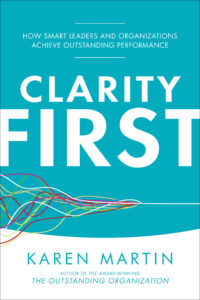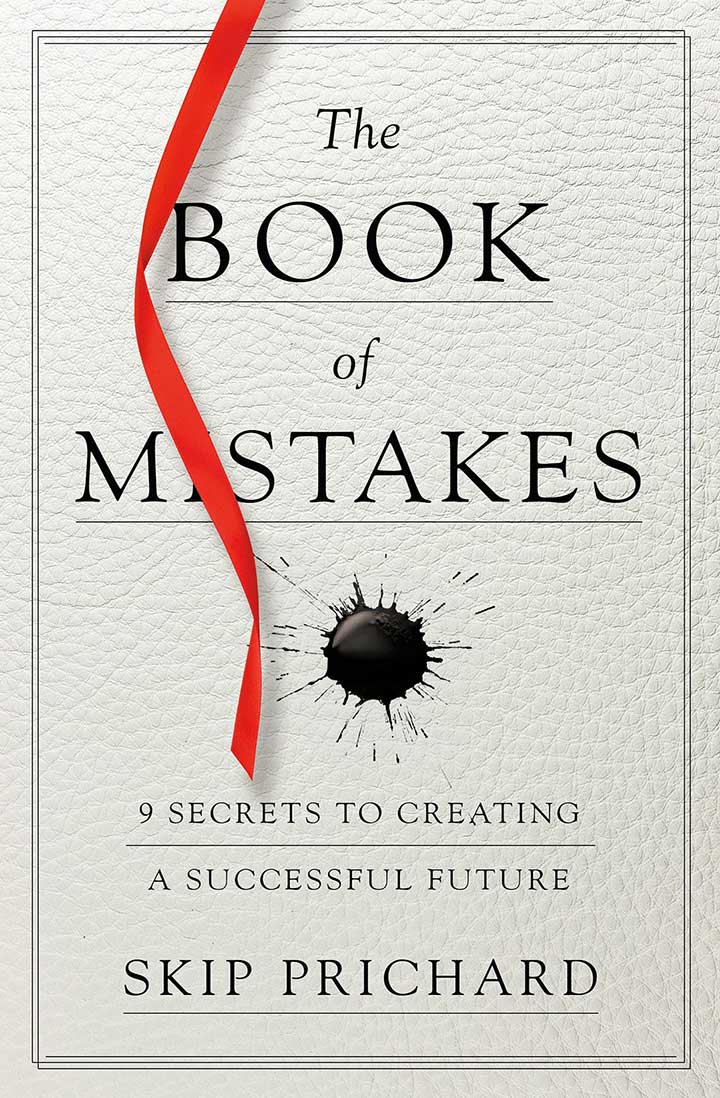Achieve Outstanding Performance
Lean management expert Karen Martin tackles the problem so many organizations and leaders face: a lack of clarity. In her new book, Clarity First: How Smart Leaders and Organizations Achieve Outstanding Performance, she gives specific recommendations on how to improve clarity and thus your overall performance.
The book helps leaders identify the organization’s purpose, set priorities, and build problem solving capabilities while developing personal clarity to be a more effective leader.
I recently spoke with Karen about the importance of clarity and the role it plays in leadership and organizational success.
The Importance of Clarity
What are some of the effects of a lack of clarity?
Lack of clarity touches organizations in small, daily ways and in large ways that introduce risks to customer satisfaction, the employee experience, the balance sheet, and compliance. An example of a “small” issue might be a customer problem that remains unsolved because no one knows who owns it. Larger problems brew when various parts of an organization work at cross purposes from each other. In the end, a lack of clarity often results in runaway expenses, market share loss, high turnover, and sluggish innovation, to name a few.
Those outcomes are often caused or at least exacerbated by the incremental accumulation of ambiguity about work that happens closer to the customer. For instance, a lack of clarity about customer requirements result in products that don’t meet true customer needs. It results in poorly designed and poorly managed processes that require heroics to execute. It results in excessive rework or productivity-sapping time spent clarifying what should have been clear to begin with. In a low-clarity environment, margin and morale erode because people do work that doesn’t fit together and doesn’t move the organization toward a common performance goal.
Clarity, in contrast, feeds an organization in the same way that fertilizer feeds soil. It nourishes everything visible, as well all the quiet and invisible activities that take place out of sight to make an organization outstanding, such as decision making. When you have it, there is greater alignment, greater collaboration, higher levels of innovation, and so on. When you don’t have it, everything becomes stressed to the point that even basic decisions require more effort that they should need.
Imagine you are leading an organization filled with well-meaning and talented people in a growing industry, but you haven’t developed a culture where everyone values holding clarity front-and-center in everything they do—foundational clarity like: why you are in business, what the organization’s top priorities are, how the organization is performing both operationally and financially, and the level of performance it wants to achieve, and other important questions that drive organizational alignment and outstanding performance. Without clarity on these issues, in the near-immediate term, the relationship between the organization and its people begins to break down. Team members begin to feel unsure that their work produces customer value or contributes to organizational success. Such uncertainty leads to frustration, low morale, and eventual disengagement, creating low productivity, talent turnover, poor customer service, loss of market share, eroded margins, and so on.
To be clear, I emphasize words such as everyone and everything because clarity requires it. Leaders are in a privileged role. You may feel that you DO have clarity. But if your direct reports don’t, or if their beliefs about the priorities of the organization are different from those of the peers they work with on a daily basis, then the organization as a whole lacks clarity even if there are pockets of clarity here and there.
Six P’s of Organizational Clarity
You identify the “Six P’s” of organizational clarity. The first is purpose and to understand why the organization exists. Would you share why organizations struggle with the first P?
Purpose is your why. Why does your organization exist? Why do you deliver the particular goods or services that you do? Purpose keeps organizations heading toward their True North goals even in times of major challenge or high distraction. Yet organizations struggle to define their purpose and put it at the center of everything they do because leaders under-appreciate the value of having a compelling and clearly communicated why.
Instead, leaders tend to focus on “what” they do. We build homes. We provide healthcare. We manufacture electrical components. We design software. Some are also able to talk about the problem their good or service solves for their client, which is a deeper form of what: We give low-income people the means to live in a safe home; we provide a way for people to do their banking from any location on the earth, and so forth. Leaders can get so good at talking about products, they forget that what isn’t enough to connect with, inspire, and engage people.
I’m not suggesting that knowing what your organization does isn’t important. It is. It isn’t enough motivation, however, to keep everyone in the organization moving in the same direction. What misses that spark—the resonance—that comes with putting a meaningful purpose at the center. Only purpose can do that for an organization. Which would you rather do for the eight-plus hours you work every day: install technology that helps reduce insurance costs (a what) or save lives (a why)? Both are ways to describe a single product.
Purpose provides people with the context they need to understand how the organization’s strategy, its’s resources, and its priorities move it toward an organizational True North. It allows employees, customers, and partners to align around why you do what you do, and to feel proud of their contribution to it.
The positive benefits from purpose can’t be overstated. Employees who understand where they fit in the organizational purpose are in a position to contribute their best ideas to fulfill it. Customers benefit through a more coherent and consistent experience. Those advantages create an incentive for organizations to not settle for what, and instead tackle the challenge of defining their why.
Purpose at the Center of Everything
Often leaders define the purpose of an organization and then have a hard time making sure the organization understands, supports, and then articulates it. What advice do you have for leaders in this effort?
For purpose to drive clarity it needs to be at the center of everything the organization does. Why are we having this meeting? Why do we care about these key performance indicators? Why are we choosing to invest resources in solving this problem? Putting purpose at the center creates high levels of intentionality, which leads to more appropriate decisions and actions. Leaders provide powerful clarity by defining purpose in all that they do. That’s the first step. To help the organization understand and support the purpose, however, leaders have to communicate it, socialize it, and make it an organizational expectation that people keep purpose top-of- mind when making decisions, planning meetings, communicating, and taking action of any sort.
Communicating an organization’s purpose requires consistent reminders. Physically post it on visual information boards. Add it to your security badges. Integrate it into your job postings so that prospective employees understand what you are about and can decide proactively if they want to be part of it. Use it in the onboarding of new employees so they understand the standard upon which all actions and decisions will be based. Come back to it in every discussion about key business decisions.
Toyota is one of the best at this. It’s not about the car—it’s about reliable transportation. Toyota’s focus on quality and reliability instills a sense of confidence in the customer that their Toyota is going to get them where they want to go. Their tag line, “Let’s Go Places” captures that sensibility, which also carries through in the Toyota attitude about developing people inside the organization.
Google is another organization who keeps purpose front and center. They are not merely about creating cool technology. Their what is organizing the world’s information. Their why is making it universally accessible and meaningful to significantly improve the lives of as many people as possible. Not just a little. Significantly. And they don’t seek to improve just some lives. They seek to improve all lives. Now that’s a powerful purpose. Decision making is much easier with clarity of purpose: does this idea or project improve the lives of all or not?
An organization’s why needs to be reinforced through purpose-driven decisions and action. Purpose has to live in the behaviors, actions, and decisions of the organization, especially those made by senior leaders. When team members at all levels see the ways in which purpose drives an investment, or results in the end of a business partnership, purpose becomes real, tangible, and salient to the work they do for the customer.
Watch the Drift
Shifting priorities is a criticism from most employees in organizations. How do leaders best keep the organization from drifting while also maintaining flexibility to take on new growth areas that emerge?
Beyond the fact that many organizations don’t have a clearly defined purpose, one of the top reasons why organizations have trouble improving performance is because they aren’t clear about what they need to accomplish in a defined period of time—often a fiscal year. They lack clearly defined priorities.
When I challenge leaders and suggest that their organization lacks priorities, many respond with “Of course we have priorities!” I understand the response. After all, every leader can tick off a list of important-sounding investments or efforts they see as moving the organization forward. But dig a bit deeper and a few common issues appear.
The first is that the individual priorities lack consensus throughout the organization. One leader may have five must-do priorities on her list, only two of which appear on the list of the next leader. When this happens, work teams get pulled in conflicting directions trying to respond to leader demands and realize an incoherent set of expectations.
Second—and this is almost immediately obvious—is that organizations try to do too much at one time. They want to solve runaway costs, build a new manufacturing plant, expand into a new geography, and so on, all in the same year with the same financial resources and input from the same work teams. These ambitious plans require people to divide their time and attention across too many disparate efforts. It’s like standing in front of an all-you-can-eat buffet and thinking you can eat a lot of everything without growing ill.
The results of taking on too much is that nothing gets done. Or it doesn’t get done well. People lose time when they’re forced to shift from one task to the next. Lost time lowers productivity, and leads to overwork as people try to make up the difference. That has significant negative impacts on people’s quality of life. Work quality also suffers. And perhaps one of the largest, overlooked issues is the volume of wasted work done in environments with unclear priorities. When everything is a priority, nothing is. People don’t know what actions will bring the most value today, and they do work they think contributes to a priority only to find that work isn’t needed. Over time, these issue wear at people as they go to heroic lengths to serve customers, only to be confronted with the fact that their effort isn’t bringing value.
The third issue I see is that organizations don’t connect priorities to a clear problem that needs to be a solved or a goal the organization would like to meet. In the absence of a problem-framed priority list, leadership teams decide what to work on based on what seems most urgent, most popular, or most feasible at that moment—not based on what will truly result in the best results for the organization. Organizations that fall into this trap end up with a long list of priorities that are, in reality, pet projects or fire drills—not the important priorities that can move the organization toward its goals.
To best address the temptation to want to do it all and do it all now, I recommend strategy deployment, the most effective leadership practice I have seen to date for setting priorities while maintaining the ability to flex those priorities if legitimate needs arise. Strategy deployment is a methodology for clarifying priorities and gaining organization-wide consensus and commitment to them. Quality management professor Kaoru Ishikawa conceptualized the methodology in the 1950s, and Professor Yoji Akao, a planning specialist, then codified and popularized it. The practice is also referred to as hoshin kanri or hoshin planning, and in some circles, policy deployment.
A key reason why strategy deployment is so powerful is that it addresses some of the common priority traps I describe above as part of the process. For one, strategy deployment asks leaders to define priorities in “from-to” problem terms versus solution terms. No longer can organizations say they want to “implement a new ERP system.” Instead, they need to define a clear problem. When they do that, they often discover, for example, that a new ERP system won’t solve their problem and that their money is far better spent in other ways.
Strategy deployment plan development likewise involves a great deal of interaction between leaders, which creates an active environment of collaboration and consensus building across the organization. Leadership consensus then extends to the broader organization through a process called catchball that allows leaders to share the proposed priorities with their direct reports and listen to their views on them. Through this approach, the organization as a whole is bought in before priority execution begins, enabling a higher level of commitment to the chosen priority items. Eventually this type of consensus building extends all the way to the front lines—the people who deliver direct value to customers.
Of course, circumstances do sometimes necessitate a pivot. But I have found that the need for substantive priority change is rare. More often, organizations that go through the process of defining what really matters in problem terms, and gaining consensus on those priorities, are better able to assess whether an emerging issue warrants a priority shift. It rarely does. More often, issues that in the past would have triggered a 180-degree turn with strategy deployment generate a measured response of wait and watch.
How to Surface Hidden Problems
What are some of the best ways you’ve seen leaders use to surface problems that may be hidden?
I rely on three proven methods: “go and see”; understand how the organization truly delivers value; and understand how the organization is doing operationally in real time.
Go and see means going to the gemba, the place where the work is done. If you’re an auto manufacturer, the gemba is the floor of the manufacturing plant and on the sales floor of the dealerships that sell and service the vehicles. In hospitals, the gemba includes patient care units, the laboratory, and the cafeteria, to name a few. The gemba can be in offices and cubicles, on construction sites, or inside law enforcement vehicles.
 Visiting the place where the work is done should be a part of leader standard work. In other words, a common practice that happens at regular intervals, not some rare event. Gemba visits allow leaders to gain clarity about work systems at a level of detail that is usually hidden from them, providing valuable insights that drive better decisions and more purposeful action. These visits bring the most value when conducted in a spirit of curiosity, humility, and a desire to learn. It allows the experts in that work—your organization’s individual contributors—to teach the leader and creates an opportunity for open communication where people feel safe sharing problems.
Visiting the place where the work is done should be a part of leader standard work. In other words, a common practice that happens at regular intervals, not some rare event. Gemba visits allow leaders to gain clarity about work systems at a level of detail that is usually hidden from them, providing valuable insights that drive better decisions and more purposeful action. These visits bring the most value when conducted in a spirit of curiosity, humility, and a desire to learn. It allows the experts in that work—your organization’s individual contributors—to teach the leader and creates an opportunity for open communication where people feel safe sharing problems.
The second way to surface problems is to gain an intimate understanding of how the organization delivers value to the customer. Value stream analysis and design uses a mapping technique that enables leaders to visualize how value flows through the organization and toward the customer—so they can make strategic decisions about eliminating obstacles to this flow. The maps include all of the functions involved in delivering value, the hand-offs between functions as work passes through the work stream, and a timeline showing the degree of work effort, the time work spends in queue, and the quality of the output produced at each step. Leaders come into the first day of our value stream transformation sessions believing they know how the organization delivers value to the customer. They invariably discover that no one person on the leadership team understood the full picture. At some point in nearly every session—and often at many points—a leader says, “Really?” in response to information provided by a peer in a different function. The sessions provide profound clarity about how the organization delivers value and what the performance problems truly are, which enables far crisper decision making about transforming how work gets done and value is delivered.
The third way to surface problems is to know how you are performing today compared to how you want to be or need to be performing in all areas—that includes financial performance as well as performance around quality, customer satisfaction, employee safety, and other issues that reflect the health of the organization. That knowledge comes to organizations that consistently and openly measure performance using a set of balanced metrics.
Organizations need to define a relevant and varied set of key performance indicators (KPIs)—no more than nine at an organization level—that reflect current financial and operational performance, and include desired targets. With this level of clarity, organizations can more successfully focus resources on improvements that move organizational performance closer to the targets. Only through regular and balanced performance measurement can leaders see how the organization is truly doing, and see when performance is stalling or moving away from where they want it to be or need it to be.
As critical as choosing those KPIs and tracking them is to visually display the results in accessible/physical locations. Having and tracking KPIs helps no one if that information lies hidden away on someone’s computer. In contrast, when organizations take the time to visually display their performance metrics, it keeps an entire workforce focused on what matters and the means for everyone to understand how their work contributes to the results.
Lead with Clarity of Thought
Leading with clarity of thought, word, and action is a powerful section. Would you comment on this?
Organizational clarity begins with leadership clarity, and I’m not alone in seeing the strong connection. Consider every leadership book, newspaper profile, or article that highlights the qualities possessed by widely-admired leaders. At root, these profiles all emphasize the multiple ways in which successful leaders value and pursue clarity, even if the authors don’t specifically use that word. Some examples include Alan Mulally, who during his leadership tenure at Ford encouraged his leadership team to raise problems so that everyone knew about them and could work to solve them together. Or Steve Jobs, whose second tenure at Apple is known for the launch of multiple consecutive market-leading products, innovation the organization was able to achieve because Jobs had and communicated clarity about organizational purpose and the standards to which he held each product.
It is not only the organization that benefits when leaders value clarity and encourage the teams to pursue it as well. Operating with greater clarity also pays back in personal dividends that begin to accrue almost immediately when leaders develop the clarity-enabling personal habits I recommend. These habits include developing a daily mindfulness practice, listening while fully present, operating with curiosity and humility, and attending to your physical and emotional needs, among others. In addition to the way they result in better clarity, they also bring reduced stress, better communication with colleagues and your loved ones, and increased quality of life. When you actively pursue and operate with greater clarity, you become a better person and a more productive and effective leader.
For more information, see Clarity First: How Smart Leaders and Organizations Achieve Outstanding Performance.


